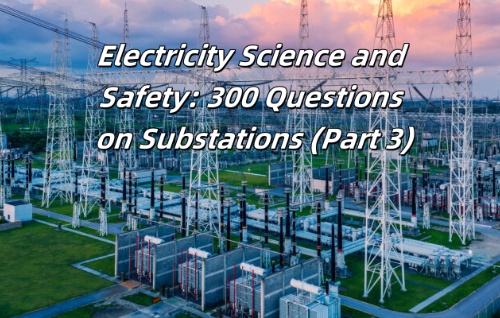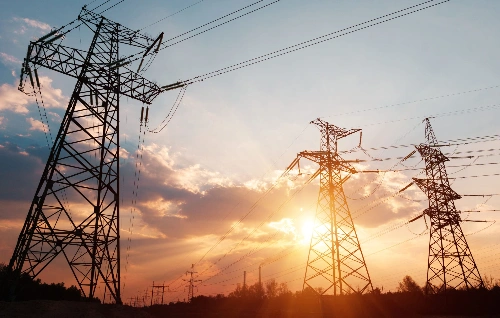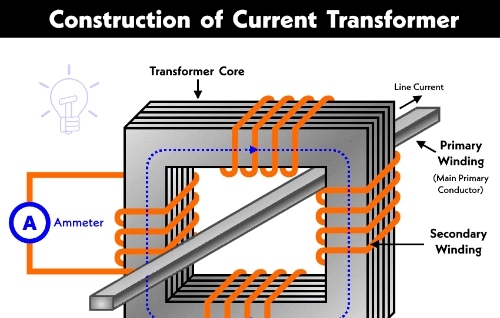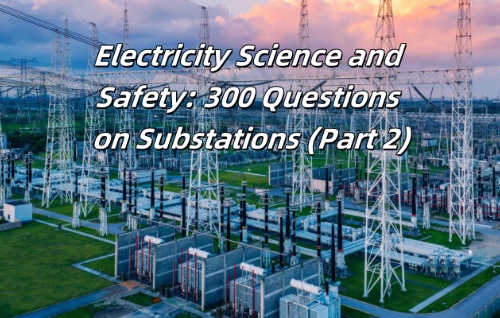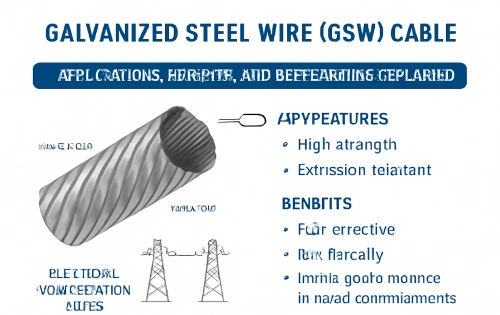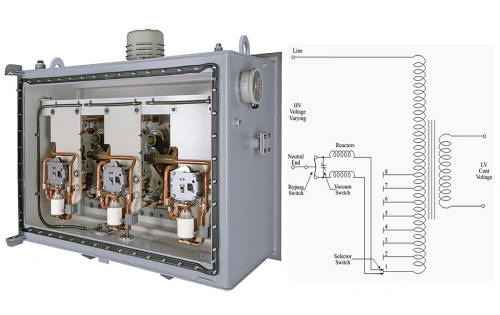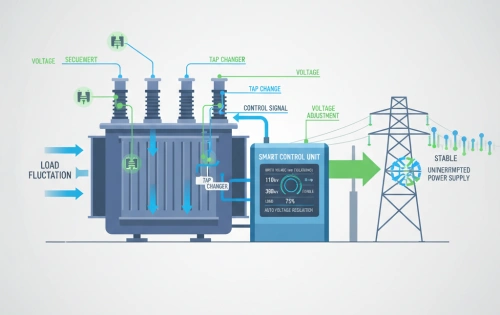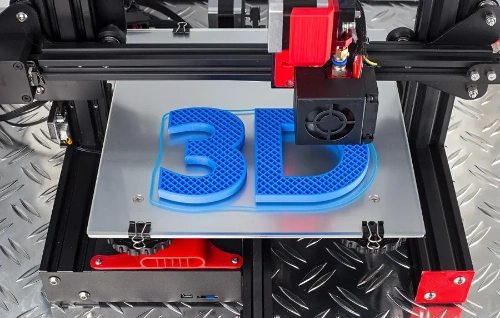Electricity Science and Safety: 300 Questions on Substations (Part 4)
Transformers play a critical role in power systems by enabling efficient voltage regulation and energy transmission. However, over time, these vital components can encounter various problems due to aging, environmental stress, electrical faults, or mechanical failures. Common issues include overheating, abnormal oil levels, insulation degradation, unusual noises, or internal short circuits. If left unaddressed, such problems may lead to equipment failure, power outages, fire hazards, or safety risks.
This section explores how to identify and resolve transformer-related issues through proven diagnostic methods—such as infrared thermography, oil analysis, and partial discharge detection—alongside preventive maintenance strategies and emergency response actions. By examining real-world questions and answers, readers will gain practical insights into safe and effective transformer operation and fault management.
151. Why is it necessary to install low voltage lockout for overcurrent protection?
A: The operating current of the overcurrent protection is set according to the maximum load current to be avoided. In some cases, it cannot meet the sensitivity requirements. Therefore, in order to improve the sensitivity of the overcurrent protection in the event of a short circuit fault and improve the conditions for avoiding the maximum load current, a low voltage lockout is added to the overcurrent protection.
152. Why are overcurrent protection devices installed on all three sides of a three-winding transformer? What is their protection range?
A: When a busbar short-circuit fault occurs on any side of the transformer, overcurrent protection activates. Because overcurrent protection is installed on all three sides, it can selectively clear the fault without shutting down the transformer. Overcurrent protection on each side serves as backup protection for the busbar and line on that side, while overcurrent protection on the main power supply side serves as backup protection for the other two sides and the transformer.
153. What kind of fault gas protection action?
Answer: ( 1 ) Multiphase short circuit inside the transformer. ( 2 ) Turn-to-turn short circuit, short circuit between the winding and the core or the casing. ( 3 ) Core failure. ( 4 ) Oil level drop or oil leakage. ( 5 ) Poor contact of the tap changer or loose welding of the wires.
154. Under what circumstances is it necessary to disable the differential protection of a running transformer?
A: The differential protection should be disabled when any of the following conditions occur during transformer operation: ( 1 ) When the secondary circuit of the differential protection and the current transformer circuit are changed or calibrated. ( 2 ) When the relay protection personnel measure the current phase and differential voltage of the differential circuit. ( 3 ) When one phase of the differential protection transformer is disconnected or the circuit is open. ( 4 ) When obvious abnormality occurs in the differential circuit. ( 5 ) When the circuit breaker trips due to a false trip.
155. How are the protection ranges of sections I , II , III , and IV of zero-sequence protection divided?
A: Section I of the zero-sequence protection is set based on the maximum zero-sequence current flowing through the protection device when avoiding a single-phase short circuit at the end of the line. It cannot protect the entire length of the line. Section II of the zero-sequence protection is set in conjunction with Section I of the zero-sequence protection of the adjacent line at the same location as the protection installation . It not only protects the entire length of the line but can also extend to adjacent lines. Section III of the zero-sequence protection works in conjunction with Section II of the adjacent line and serves as backup protection for Sections I and II . Section IV generally serves as backup protection for Section III .
156. Why does the distance protection malfunction when the voltage suddenly loses?
A: Distance protection operates when the measured line impedance value ( Z=U/I ) is equal to or less than the set value. This means that when the voltage applied to the impedance relay decreases and the current flowing through it increases to a certain value, the relay operates. The voltage generates a braking torque. Current generates an operating torque. If the voltage suddenly drops, the braking torque also suddenly becomes very small. However, the current loop generates an operating torque generated by the load current. If the locking circuit fails at this point, the distance protection will malfunction.
157. Why does the impedance relay in the distance protection device use 0° wiring?
Answer: Distance protection is a protection device that reflects the distance from the installation location to the fault. Therefore, the impedance relay as a distance protection measuring element must correctly reflect the distance from the short-circuit point to the protection installation location and not be affected by the fault type. The use of 0° wiring of phase-to-phase voltage and phase-to-phase current can meet the above requirements, so distance protection generally uses 0° wiring.
158. How should the line distance protection voltage circuit be switched?
A: When switching a transmission line from one busbar to another due to power system operation requirements or load balancing, the voltage used by the distance protection must also be switched to the voltage transformer on the other busbar. During the switching process, the distance protection must not lose voltage. If the voltage is disconnected, the DC power supply must be disconnected first. This will prevent the distance protection from tripping inadvertently.
159. What should be paid attention to during the operation of distance protection?
Answer: The distance protection should have a reliable power supply during operation , and the operating voltage transformer should be prevented from back-charging the standby voltage transformer, rendering the line break locking device ineffective. If the secondary fuse of the voltage transformer happens to blow at this time, the distance protection will malfunction due to voltage loss.
160. How are electromagnetic relay protection and transistor relay protection started?
Answer: In electromagnetic relay protection devices, after the relay coil is energized, the armature-band contact connects or disconnects the circuit to start protection; while in transistor protection devices, after the current reactance transformer is energized, the potential change formed on its secondary side causes the transistor to turn on or off to start protection.
161. What special protections does a 500KV transformer have? What is its function?
Answer: ( 1 ) Overexcitation protection is used to prevent the transformer from sudden load shedding or a sudden increase in magnetic flux density due to overvoltage in the excitation system, which may cause overheating of the core and other metal parts. ( 2 ) 500kV and 220kV low impedance protection. It serves as a backup protection for differential protection when a phase-to-phase short circuit occurs in the transformer windings and lead wires.
162. What are the regulations for the use of current phase comparison bus differential protection?
Answer: ( 1 ) The busbar oil circuit breaker must be in operation, and both busbars must have power supply circuits. ( 2 ) When the busbar oil circuit breaker is disconnected, the busbar differential function is non-selective. ( 3 ) When the busbar is bypassed, the busbar current circuit must be switched to the differential circuit. ( 4 ) When operating with a single busbar, a non-selective three-pole small knife switch should be switched on before the switching operation. At this time, the busbar fault will cut off all power supply oil circuit breakers.
163. What are the advantages and disadvantages of current phase comparison bus differential protection?
Answer: It is flexible and convenient to operate, eliminating the possibility of human error. The wiring and fixed connection method of the TA circuit is simple, the action is adjustable , and the selectivity is strong.
164. What protection functions does the CLS166 microcomputer protection have?
Answer: It is equipped with three-stage phase-to-phase distance protection, two-stage grounding distance protection that is activated according to the zero-sequence current exceeding the limit, one stage of overcurrent protection IJ , one stage of overcurrent protection IJP that is automatically activated after TV line is disconnected , and three-phase primary reclosing.
165. How to change the set value zone of CSL166 microcomputer line protection?
Answer: ( 1 ) First, press the dial button on the panel to select the desired setting area. ( 2 ) The panel displays SET-CHG , P-RST , and press the signal reset button to confirm. The confirmation time is about 20 seconds . After observing that the panel displays the correct input quantity change, press the QUIT button to reset the LCD. ( 3 ) Press the SET button and the right button to select the print menu PNT , and press the SET button to confirm. This will print the setting sheet for verification of the setting.
166. What does the DFP-500 protection exception report contain ?
Answer: When the operation is abnormal or the device self-diagnoses an error alarm, the LCD will display an abnormality report, which includes the time and corresponding content when the abnormality or self-diagnostic error occurred.
167. What could be the cause of the alarm light? How should I handle it?
A: This indicates that the CPU has a fault and should be stopped and the CPU plug-in replaced. It should be noted that this phenomenon may also occur when the CPU plug-in test switch is in the " debug " position, the monitoring plug-in is in the running position, and the CPU inspection switch is not exited.
168. What is quasi-simultaneous paralleling? What are the conditions for paralleling?
Answer: When the following conditions are met or the deviation is not large, the paralleling method for closing the power supply switches is quasi-synchronous paralleling. ( 1 ) The voltages on both sides of the parallel switch are equal, with a maximum allowable correlation of less than 20% . ( 2 ) The frequencies of the power supplies on both sides of the parallel switch are the same. Generally, a frequency difference of 0.5 Hz is sufficient for paralleling. ( 3 ) The phase angles of the voltages on both sides of the parallel switch are the same. ( 4 ) The phase sequence on both sides of the parallel switch is the same.
169. What will happen if one coil of a synchronous relay loses power during normal operation? How should it be handled?
A: When one coil of a synchronous relay loses power, the relay will make a sound and enter the operating state, that is, the lower contact opens and the upper contact closes. At this time, the synchronous reclosing circuit breaker should be shut down and a professional should be notified to investigate the cause.
170. What is the principle of high-frequency remote tripping?
Answer: This type of protection uses high-frequency current to transmit tripping signals. When a fault occurs in the zone, after the protection device stage I is activated, the circuit breaker on this side will be instantly tripped, and a high-frequency signal will be sent to the opposite side at the same time. The side that receives the high-frequency signal will compare the high-frequency signal with the protection stage II action. If stage II is activated, the action will be accelerated to trip, thereby achieving rapid removal of the entire line of faults in the zone.
171. Why should 220KV lines be equipped with comprehensive reclosing devices?
A: 220kV lines are neutral-grounded systems. Because single-phase grounding faults are the most common, circuit breakers are equipped with split-phase operating mechanisms. When a single-phase grounding fault occurs, the protection only trips the circuit breakers on both sides of the faulty phase, while the unfaulted phases remain untripped. This prevents operational overvoltage and improves system stability. When an interphase fault occurs, the protection device trips the three-phase circuit breakers on both sides. Alternatively, when single-phase tripping with single-phase reclosing or three-phase tripping with three-phase reclosing is required, this can also be accomplished using the integrated reclosing mechanism.
172. How many operating modes does the integrated reclosing system have? How do they work?
Answer: The integrated reclosing is achieved in three ways by the switch QK . ( 1 ) Integrated reclosing mode. After a single-phase fault trips, the single phase recloses. After reclosing on a permanent fault, the three phases reclose. After a phase-to-phase fault trips the three phases, the three phases reclose. After reclosing on a permanent fault, the three phases trip again. ( 2 ) Three-phase reclosing mode. After any type of fault, the three phases trip, the three phases reclose (check synchronization or no voltage). After reclosing on a permanent fault, the three phases trip again.
( 3 ) Single-phase reclosing mode. In case of single-phase fault, the fault phase is tripped and then the single phase is reclosed. In case of reclosing on permanent fault, the three phases are tripped. In case of interphase fault, the three phases are tripped and then the circuit breaker does not reclose.
173. Why is it necessary to use post-reclosing acceleration on the side of the dual power supply line equipped with a no-pressure identification reclosing switch?
A: When the no-voltage identification reclosing device recloses the circuit breaker on a permanent fault line, the accelerated protection after reclosing will operate without time limit, causing the circuit breaker to trip immediately. This can avoid expanding the scope of the accident, benefit system stability, and protect electrical equipment from damage.
174. Why should the starting circuit of the automatic transfer device be connected in series with the voltage contacts of the backup power supply voltage relay?
Answer: In order to prevent the automatic transfer device from being activated when the backup power supply is out of power and transferring to the power-free equipment, the voltage contacts of the backup power supply voltage relay are connected in series in the starting circuit of the automatic transfer device to check whether the backup power supply has voltage, ensure the correctness of the automatic transfer device's operation, and also speed up the operation time of the automatic transfer device.
175. Why are the no-voltage contacts of the two voltage relays on the high and low voltage sides of the transformer automatic switching device connected in series in the starting circuit?
A: This is to prevent the automatic transfer device from malfunctioning due to a blown voltage transformer fuse, and to ensure the correct operation of the automatic transfer device. In this way, even if one set of voltage transformer fuses blows, the automatic transfer device will not malfunction.
176. What are the starting methods of the fault recorder?
A: The starting mode should be selected to ensure that the fault recorder can start reliably when any type of fault occurs in the system . Generally, the starting modes include the following: negative sequence voltage, low voltage, overcurrent, zero sequence current, and zero sequence voltage.
177. How does the synchronous detection relay work?
A: The two coils of the synchronous detection relay are connected to the running and starting synchronous voltage busbars, respectively. When voltage appears on the synchronous voltage busbar, the synchronous detection relay operates. If the voltage phase difference on both sides of the synchronous point exceeds the set operating angle of the synchronous detection relay, the relay operates, the normally open contact opens, and the closing pulse circuit is disconnected, preventing the circuit breaker from closing.
178. What are the basic requirements for oscillation locking devices?
Answer: ( 1 ) When there is no fault in the power system and oscillation occurs, the protection should be locked, and the lock should not be released as long as the oscillation continues. ( 2 ) When a short circuit occurs within the protection range, regardless of whether the system oscillates, the protection device can operate correctly and cut off the fault.
179. What are the hazards of running a transformer at extreme temperatures for a long time?
A: Generally, the primary insulation of a transformer is Class A insulation, with a maximum operating temperature of 105 °C. During operation, the temperature of the transformer windings should be 10-15 °C higher than the upper oil temperature. If the upper oil temperature of a transformer is consistently around 80-90 °C during operation , meaning the windings are constantly around 95-105 °C, the high temperature will cause severe insulation aging, accelerate the deterioration of the insulating oil, and shorten its service life.
180. What are the consequences of parallel operation of transformers that do not meet the parallel operation conditions?
A: When transformers with different transformation ratios are operated in parallel, circulating currents will be generated, affecting the transformer's output power. If transformers with unequal percentage impedances are operated in parallel, the load cannot be distributed proportionally to the transformer's capacity, also affecting the transformer's output power. When transformers with different wiring groups are operated in parallel, the transformers may short-circuit.
181. What is electrical equipment in use?
Answer: ( 1 ) All electrical equipment that carries voltage. ( 2 ) Some electrical equipment that carries voltage. ( 3 ) Electrical equipment that carries voltage once it is operated.
182. How are high voltage and low voltage of electrical equipment divided?
Answer: High voltage: equipment with a voltage of 250V or above to the ground; Low voltage: equipment with a voltage of 250V or below to the ground.
183. What are the regulations regarding on-duty personnel removing or crossing the fence to carry out work?
A: The specific regulations are: ( 1 ) Regardless of whether the high-voltage equipment is energized or not, on-duty personnel must not remove or cross the fence to carry out work. ( 2 ) If it is necessary to remove the fence: 1 ) A supervisor must be present. 2 ) The following safety distances must be met: 10kV is 0.7 meters ; 66kV is 1.5 meters ; 220kV is 3 meters .
184. What kind of work is meant by total power outage?
Answer: ( 1 ) All indoor high-voltage equipment is powered off (including overhead lines and cable leads). ( 2 ) All doors leading to adjacent high-voltage rooms are locked. ( 3 ) All outdoor high-voltage equipment is powered off (including overhead lines and cable leads).
185. What does partial power outage and no power outage mean?
Answer: Partial power outage work refers to: ( 1 ) Partial power outage of high-voltage equipment. ( 2 ) Or a complete power outage in a room, but the doors leading to the adjacent high-voltage room are not all locked. Non-power outage work refers to: ( 1 ) Work that does not require power outage and does not pose a risk of accidental contact with conductive parts. ( 2 ) Work that is permitted on the casing of live equipment or on conductive parts.
186. What regulations must be followed when working on high-voltage equipment?
Answer: ( 1 ) Fill out a work ticket or give a verbal telephone order. ( 2 ) At least two people should work together. ( 3 ) Complete organizational and technical measures to ensure the safety of the staff.
187. What regulations should be followed when resuming work the next day after a work interruption?
Answer: When resuming work the next day: ( 1 ) You must obtain permission from the duty officer. ( 2 ) You must retrieve your work permit. ( 3 ) The person in charge of the work must carefully recheck that the safety measures meet the requirements of the work permit before you can resume work. ( 4 ) Workers are not allowed to enter the work area without the guidance of the person in charge of the work or a guardian.
188. Where is the sign “ Do not close the switch, someone is working ” hung?
Answer: A sign that reads " Do not close the switch, someone is working " should be hung on the operating handles of switches and knife switches that can supply power to the work site once closed .
189. What are the requirements for using insulating rods to open and close disconnectors or for opening and closing disconnectors and circuit breakers through transmission mechanisms?
Answer: ( 1 ) Use insulating rods to open and close disconnectors or mechanically open and close disconnectors and circuit breakers. ( 2 ) Wear insulating gloves. ( 3 ) When operating outdoor high-voltage equipment on rainy days: insulating rods should have rain covers and insulating boots should be worn; if the grounding grid resistance does not meet the requirements, insulating boots should also be worn on sunny days. ( 4 ) Switching operations are prohibited during thunderstorms.
190. What are the requirements for installing grounding wires on indoor power distribution equipment?
Answer: ( 1 ) They should be installed at the designated locations on the conductive parts of the device. ( 2 ) The paint at these locations should be scraped off and black marks should be made.
191. What is a switching operation? What is a switching operation?
A: Electrical equipment is classified into three states: operation, standby (cold standby and hot standby), and maintenance. The process of changing equipment from one state to another is called switching, and the operation performed is called a switching operation.
192. What operational errors should be avoided during switching operations?
Answer: The key points to prevent misoperation are: ( 1 ) Accidentally opening or closing circuit breakers or disconnectors. ( 2 ) Opening or closing disconnectors under load. ( 3 ) Hanging a ground wire under power (or closing a grounding knife switch under power). ( 4 ) Closing the switch with the ground wire on. ( 5 ) Asynchronous paralleling. ( 6 ) Accidentally switching on or off relay protection and grid automatic devices. In addition to the above 6 points, preventing operators from accidentally entering live compartments, accidentally climbing onto live structures, and avoiding personal electric shock are also key points to pay attention to during switching operations.
193. How to install and remove grounding wires?
Answer: The specific procedures are as follows: ( 1 ) When installing and removing the grounding wire, two people must be involved. After verifying that the equipment is indeed without power, the maintenance equipment should be immediately grounded and the three phases should be short-circuited. ( 2 ) When installing and removing the grounding wire, an insulating rod should be used and insulating gloves should be worn. ( 3 ) When installing the grounding wire, the grounding end must be connected first, followed by the conductor end, and the contact must be firm. ( 4 ) The order of removing the grounding wire is the opposite of that of installing the grounding wire.
194. What items should be checked after the circuit breaker is operated during power outage?
Answer: ( 1 ) The red light should be off and the green light should be on. ( 2 ) The on/off indicator of the operating mechanism should be in the open position. ( 3 ) The ammeter indication should be zero.
195. What should you pay attention to when closing the circuit breaker electrically?
A: When the circuit breaker is electrically closed, the green light should flash when the operating handle is turned to the pre-closing position. When the operating handle is turned to the closing end position, the ammeter should be checked at the same time. When the red light comes on, release the handle and the handle will automatically return to the closed position.
196. What are the basic requirements for isolating switches?
Answer: ( 1 ) The disconnector should have a clear disconnect point. ( 2 ) The disconnect point of the disconnector should have reliable insulation. ( 3 ) It should have sufficient short-circuit stability. ( 4 ) It should have a simple structure and reliable operation . ( 5 ) The main disconnector and its grounding switch should be interlocked.
198. Which items should be filled in the operation ticket?
Answer: ( 1 ) Pull and close the switches and circuit breakers. ( 2 ) Check the position of the switches and circuit breakers. ( 3 ) Check whether the grounding wire is removed. ( 4 ) Check the load distribution. ( 5 ) Install or remove the fuse of the control circuit or voltage transformer circuit. ( 6 ) Switch the protection circuit and check whether there is no voltage. ( 7 ) Install and remove the grounding wire. ( 8 ) Turn on and off the automatic device, control handle and reclosing device.
199. What measures should be taken with the fault recorder before the busbar is powered off or the voltage transformer is shut down?
Answer: Before the busbar is powered off or the voltage transformer is shut down, be sure to switch the voltage switch of the fault recorder to the running busbar or running voltage transformer to prevent the fault recorder from malfunctioning due to loss of voltage.
200. What are the requirements for filling in the voltage level in the work ticket and the order of filling in the safety measures column?
Answer: ( 1 ) The voltage level should always be written as "KV" . ( 2 ) The items in the safety measures column should be numbered.

